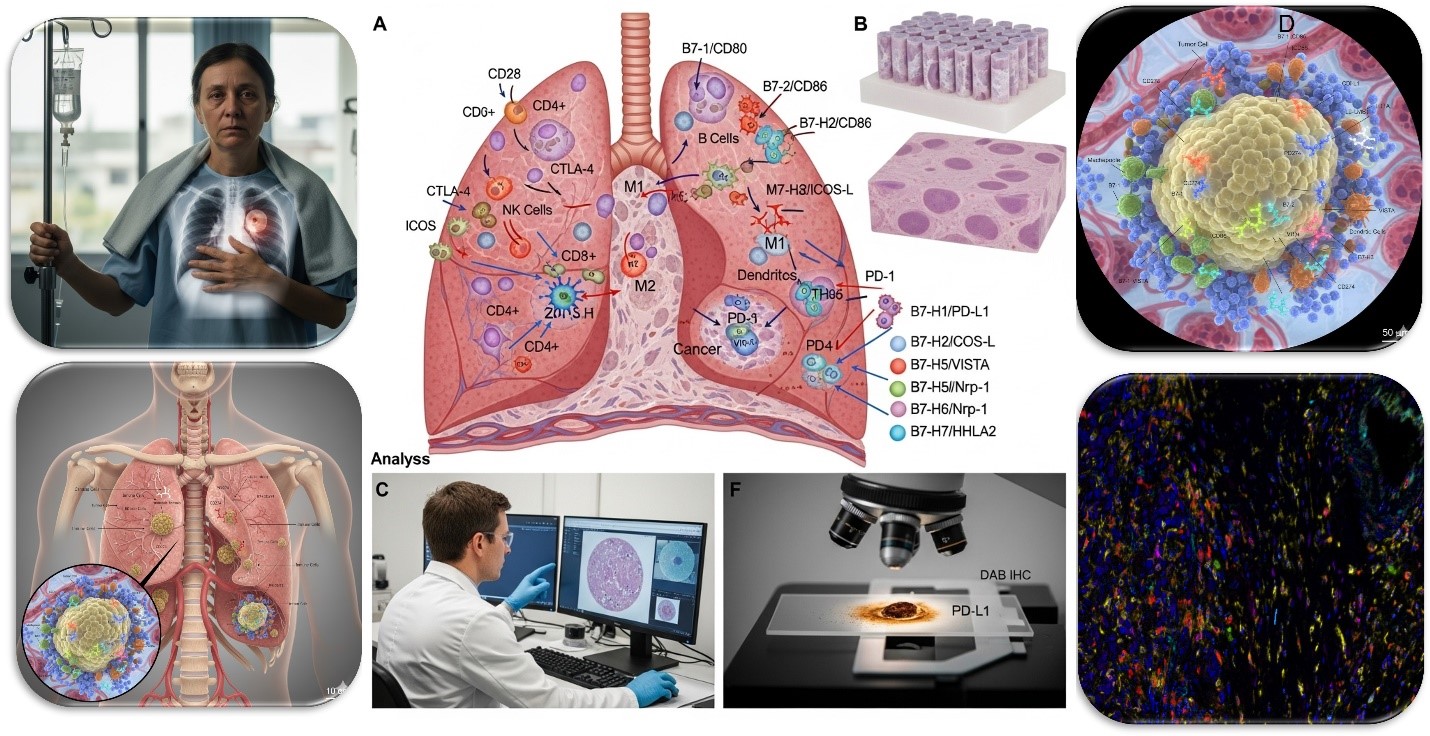Dissecting Lung Cancer Patients Tumor Immune Microenvironment
The tumor microenvironment (TME) is a complex landscape in which cancer cells and the immune system engage in a continual struggle that affects disease progression. At the heart of this interaction are B7 molecules, critical proteins that either encourage or inhibit the immune system’s T-cells from attacking tumors. In numerous cancers, the levels and locations of specific B7 molecules, such as B7-H3, B7-H4, B7-H5, and PD-L1, vary widely and have been linked to how well patients respond to treatment and their chances of recurrence. Understanding how these molecules and the immune cells interacting with them change over time is essential for developing better and more targeted therapies.
Research shows that a particular group of immune cells called myeloid cells, which are part of the body’s frontline defense, play a major role in this process. However, much remains to be learned about how these B7 molecules influence tumor growth and the immune response precisely in lung cancer. Our project aims to explore this B-7 associated immune contexture in lung cancer patients using cutting-edge techniques, including advanced imaging and digital pathology, to visualize these immune cells and molecules within tumors at different stages of development. This approach will help reveal how the immune landscape shifts as cancer evolves.
By identifying which immune cells and B7 molecules most strongly affect patient outcomes, we hope to clarify existing uncertainties about promising targets such as B7-H3 and VISTA. Ultimately, our study strives to unlock new insights into how tumors adapt and evade the immune system, guiding the development of more precise immunotherapies. This research holds real potential to improve the survival and quality of life of cancer patients by turning molecular discoveries into effective treatments.

Figure 1: Shows the general layout for dissecting Lung cancer tumor microenvironment.
References:
- Song G, Shi Y, Zhang M, Goswami S, Afridi S, Meng L, Ma J, Chen Y, Lin Y, Zhang J, Liu Y, Jin Z, Yang S, Rao D, Zhang S, Ke A, Wang X, Cao Y, Zhou J, Fan J, Zhang X, Xi R, Gao Q. Global immune characterization of HBV/HCV-related hepatocellular carcinoma identifies macrophage and T cell subsets associated with disease progression. Nature-Cell Discovery 6, 90 (2020).
- Yang H, Ye S, Goswami S, Li T, Wu J, Cao C, Ma J, Lu B, Pei X, Chen Y, Xu H, Qiu L, Afridi S, Xiang L, Zhang X. Highly immunosuppressive HLADRhi regulatory T cells are associated with unfavorable outcomes in cervical squamous cell carcinoma. International Journal of Cancer 146, (2020) 1993-2006.
- Salam A, Ali A, Nishan U, Khan N, Ibrahim M, Iqbal Z, Muhammad N, Fayyaz A, Muhammad F, Mateen A, Wu Z*, Afridi S*. Investigation of Programmed Death Ligand-1 as a new prognostic biomarker in pancreatic cancer patients. ACS Pharmacology & Translational Science. 7, 11, (2024), 3585-3591.
Acknowledgements
This publication was created by benefiting from the 2236-B Marie Sklodowska-Curie Actions (MSCA) Cofund Scholarship Programs Contribution Fund Program (TUBITAK project ID: 123C460) and Horizon Europe MSCA Cofund Postdoctoral Program (EU project ID: 101126492). Views and opinions expressed are, however, those of the author(s) only and do not necessarily reflect those of the European Union or TUBITAK. Neither the European Union nor the granting authority can be held responsible for them.
Author: Saif Ullah (Afridi), PhD
NanoBio4Can MSCA Co-Fund Fellow
TÜBİTAK MAM